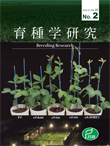Volume 20, Issue 2
Displaying 1-13 of 13 articles from this issue
- |<
- <
- 1
- >
- >|
Review
-
2018Volume 20Issue 2 Pages 105-114
Published: December 01, 2018
Released on J-STAGE: December 18, 2018
Advance online publication: October 03, 2018Download PDF (6656K)
Research Paper
-
Article type: Research Papers
2018Volume 20Issue 2 Pages 115-123
Published: December 01, 2018
Released on J-STAGE: December 18, 2018
Advance online publication: October 23, 2018Download PDF (3754K) Full view HTML -
Article type: Research Papers
2018Volume 20Issue 2 Pages 124-132
Published: December 01, 2018
Released on J-STAGE: December 18, 2018
Advance online publication: October 23, 2018Download PDF (3823K) Full view HTML
Note
-
2018Volume 20Issue 2 Pages 133-137
Published: December 01, 2018
Released on J-STAGE: December 18, 2018
Advance online publication: July 04, 2018Download PDF (5065K) -
2018Volume 20Issue 2 Pages 138-143
Published: December 01, 2018
Released on J-STAGE: December 18, 2018
Advance online publication: September 27, 2018Download PDF (4286K) -
2018Volume 20Issue 2 Pages 144-150
Published: December 01, 2018
Released on J-STAGE: December 18, 2018
Advance online publication: October 16, 2018Download PDF (2037K) -
2018Volume 20Issue 2 Pages 151-158
Published: December 01, 2018
Released on J-STAGE: December 18, 2018
Advance online publication: November 28, 2018Download PDF (4155K)
Feature Article
-
2018Volume 20Issue 2 Pages 159-163
Published: December 01, 2018
Released on J-STAGE: December 18, 2018
Advance online publication: November 09, 2018Download PDF (376K) -
2018Volume 20Issue 2 Pages 164-170
Published: December 01, 2018
Released on J-STAGE: December 18, 2018
Advance online publication: November 09, 2018Download PDF (950K) -
2018Volume 20Issue 2 Pages 171-173
Published: December 01, 2018
Released on J-STAGE: December 18, 2018
Advance online publication: November 08, 2018Download PDF (354K) -
2018Volume 20Issue 2 Pages 174-179
Published: December 01, 2018
Released on J-STAGE: December 18, 2018
Advance online publication: November 28, 2018Download PDF (498K) -
2018Volume 20Issue 2 Pages 180-184
Published: December 01, 2018
Released on J-STAGE: December 18, 2018
Advance online publication: October 13, 2018Download PDF (366K) -
2018Volume 20Issue 2 Pages 185-191
Published: December 01, 2018
Released on J-STAGE: December 18, 2018
Advance online publication: November 10, 2018Download PDF (413K)
- |<
- <
- 1
- >
- >|
